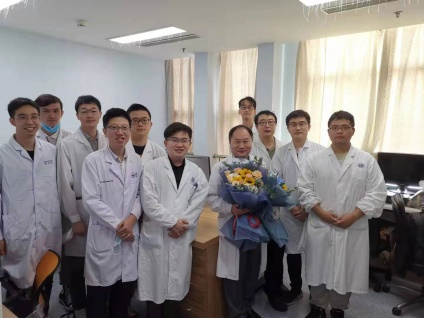#br#
NRR:上海交通大学张晓华团队认为调控琥珀酰化修饰是脑卒中治疗的潜在靶点
撰文:廉杰
#br#
脑卒中是全球范围内第二大死亡原因和第一大致残原因,发病后的神经保护是治疗的重点和难点。近年来,近年来,蛋白质组学的发展确定了许多参与脑卒中病理生理机制的翻译后修饰分子,并发现了琥珀酰化是脑卒中后细胞代谢危机的一个标志。琥珀酰化可以通过调节代谢酶的活性来调节代谢途径,因此缺血后器官中细胞琥珀酰化水平的上调被认为与线粒体功能障碍和能量代谢障碍紧密相关。SIRT5以其脱琥珀酰作用而被认为是蛋白琥珀酰化的关键酶,且可通过去除许多代谢酶的琥珀酰化修饰来发挥作用。然而,SIRT5和琥珀酰化在脑卒中损伤机制的作用仍需要进一步深入和全面的研究。近期,上海交通大学张晓华团队在《中国神经再生研究(英文版)》(Neural Regeneration Research)上发表了题为“Succinylation modification: a potential therapeutic target in stroke”的综述,阐释了琥珀酰化修饰通过调节能量代谢、氧化应激以及神经炎症反应等途径影响了脑卒中后的细胞损伤,同时总结了调节琥珀酰化的途径尤其是通过脱琥珀酰化酶SIRT5调控细胞琥珀酰化。因此,该综述认为SIRT5作为调控蛋白琥珀酰化的重要环节,其可能在未来脑卒中后神经保护的治疗中起到关键作用。 廉杰,刘文武为论文共同第一作者, 张晓华和胡琴为论文共同通讯作者。
琥珀酰化是一种蛋白质修饰,通过加入琥珀酰基来进行,通常发生在赖氨酸残基上,琥珀酰辅酶A是赖氨酸琥珀酰化的辅因子[1]。琥珀酰基可以中和赖氨酸固有的阳性电荷,并由于羧酸基团的存在而产生显著的负电荷(-1)。这种改变会导致染色质结构变得不那么紧密。此外,与其他常见的翻译后修饰(例如乙酰化和磷酸化)相比,琥珀酰化的大小明显较大(约100道尔顿)。因此,琥珀酰化可能会更明显地改变蛋白质的结构,从而改变蛋白质的功能[2]。琥珀酰化主要发生在线粒体中。琥珀酰化会影响代谢酶活性并调节代谢途径,因此根据环境营养调整代谢[3-5]。此外,琥珀酰化还发生在核心组蛋白中,并对基因表达和DNA修复起到重要作用[6]。
琥珀酰化反应可分为非酶促反应和酶促反应两种机制。目前这个反应是由琥珀酰基转移酶还是由蛋白质表面上的赖氨酸残基与琥珀酰辅酶A被动反应主导这个过程,仍存在争议。文章总结了琥珀酰化对代谢各个环节的影响,包括糖酵解、三羧酸循环、脂质代谢和氨代谢等。此外,研究表明,SIRT5是线粒体中的一个重要去乙酰化酶。SIRT5对于去乙酰化的基质酶和氧化磷酸酰化酶活性的调节作用已经得到证实,而且SIRT5能够特异性地去除线粒体蛋白中的琥珀酰化修饰[7]。因此,SIRT5在细胞代谢调节中扮演着关键角色,而且在调控线粒体代谢方面的作用与赖氨酸琥珀酰化的关系非常密切。文章还总结了调节SIRT5表达和功能的途径,有转录调节、翻译后修饰、miRNA以及小分子药物。
已有报道称,细胞琥珀酰化是脑细胞代谢受损的标志。在病理条件下,已有研究发现琥珀酰化修饰在肿瘤发生和神经退行性疾病(如阿尔茨海默病)中起到调节代谢过程的关键作用[8-10]。最近的研究则揭示了SIRT5调控的琥珀酰化与脑血管疾病,特别是脑卒中之间的潜在关系。文章主要从维持线粒体能量代谢、改善氧化应激及调节免疫炎症三个角度总结了琥珀酰化在脑卒中的作用。例如蛋白激酶Cε (PKCε) 可以通过增强烟酰胺磷酸核糖转移酶来促进脑细胞中SIRT5介导的脱琥珀酰化。NAD+水平的升高可以提高SIRT5活性,在PKCε激活的细胞线粒体能量产生中增强脱琥珀酰化作用[11]。缺血后细胞内反应性氧化物(ROS)积累是与神经细胞死亡相关的重要因素,而SIRT5作用于在ROS解毒中起重要作用的酶,对缺血损伤具有保护作用。Cu/Zn-SOD是线粒体中关键的抗氧化酶,负责将O2−转化为H2O2。SIRT5介导的脱琥珀酰化可以显著增强Cu/Zn-SOD减少细胞ROS的能力[12, 13]。在出血性卒中如蛛网膜下腔出血(SAH)中也能观察到琥珀酰化对代谢相关酶的影响。SAH后SIRT5表达下调,导致柠檬酸合酶(CS)的过度琥珀酰化,自发地抑制ATP合酶但增加ROS产生,导致急性期SAH中的神经元细胞死亡和神经功能障碍。使用白藜芦醇后,SIRT5及ATP合酶的去琥珀酰化被激活,从而恢复了线粒体代谢并减轻早期脑损伤[14]。因此,SIRT5的激活和其脱琥珀酰化活性可以保护三羧酸循环不受缺血引起的线粒体功能障碍和ROS损伤,从而维持缺血细胞的能量生成。
总之,琥珀酰化和去琥珀酰化的动态调节对于大脑代谢平衡非常重要。异常的琥珀酰化已被认为是中风后能量代谢受损的指标。作为一种重要的去琥珀酸化酶,SIRT5能调节多种代谢途径,改善细胞对缺氧缺血环境的适应性。增强SIRT5活性的药物已被用于促进去琥珀酸化和改善线粒体代谢,并在实验性脑卒中研究中观察到潜在的神经保护作用。因此,该SIRT5作为调控蛋白琥珀酰化的重要环节,其可能在未来脑卒中后神经保护的治疗中起到关键作用。
#br#
团队介绍:
第一作者:廉杰,上海交通大学医学院临床医学系
并列第一作者:刘文武,上海海军军医大学,副研究员
通讯作者:张晓华,上海交通大学医学院附属仁济医院,神经外科科主任,医学博士,主任医师,博士研究生导师,Walter E.Dandy神经外科培训中心主任,亚洲神经外科学会浦江培训中心主任,中华医学会神经外科分会委员,中国医师协会脑血管病、脑肿瘤专委会委员,中国医促会颅底外科分会常委,上海市医学会神经外科分会常委,脑肿瘤组副组长
并列通讯作者,胡琴,上海交通大学医学院附属仁济医院,副研究员

#br#
参考文献:
[1] Zhang Z, Tan M, Xie Z, et al. Identification of lysine succinylation as a new post-translational modification. Nat Chem Biol. 2011;7:58-63.
[2] He H, Hu Z, Xiao H, et al. The tale of histone modifications and its role in multiple sclerosis. Hum Genomics. 2018;12:31.
[3] Park J, Chen Y, Tishkoff DX, et al. SIRT5-mediated lysine desuccinylation impacts diverse metabolic pathways. Mol Cell. 2013;50:919-930.
[4] Weinert BT, Scholz C, Wagner SA, et al. Lysine succinylation is a frequently occurring modification in prokaryotes and eukaryotes and extensively overlaps with acetylation. Cell Rep. 2013;4:842-851.
[5] Chen H, Xu H, Potash S, et al. Mild metabolic perturbations alter succinylation of mitochondrial proteins. J Neurosci Res. 2017;95:2244-2252.
[6] Smestad J, Erber L, Chen Y, et al. Chromatin succinylation correlates with active gene expression and is perturbed by defective TCA cycle metabolism. iScience. 2018;2:63-75.
[7] Li L, Shi L, Yang S, et al. SIRT7 is a histone desuccinylase that functionally links to chromatin compaction and genome stability. Nat Commun. 2016;7:12235.
[8] Li F, He X, Ye D, et al. NADP(+)-IDH mutations promote hypersuccinylation that impairs mitochondria respiration and induces apoptosis resistance. Mol Cell. 2015;60:661-675.
[9] Wu S, Wei Y, Li J, et al. SIRT5 represses neurotrophic pathways and Abeta production in Alzheimer's disease by targeting autophagy. ACS Chem Neurosci. 2021;12:4428-4437.
[10] He L, Wang J, Yang Y, et al. Mitochondrial Sirtuins in Parkinson's disease. Neurochem Res. 2022;47:1491-1502.
[11] Morris-Blanco KC, Dave KR, Saul I, et al. Protein kinase C epsilon promotes cerebral ischemic tolerance via modulation of mitochondrial Sirt5. Sci Rep. 2016;6:29790.
[12] Okado-Matsumoto A, Fridovich I. Subcellular distribution of superoxide dismutases (SOD) in rat liver: Cu,Zn-SOD in mitochondria. J Biol Chem. 2001;276:38388-38393.
[13] Fukai T, Ushio-Fukai M. Superoxide dismutases: role in redox signaling, vascular function, and diseases. Antioxid Redox Signal. 2011;15:1583-1606.
[14] Xiao ZP, Lv T, Hou PP, et al. Sirtuin 5-mediated lysine desuccinylation protects mitochondrial metabolism following subarachnoid hemorrhage in mice. Stroke. 2021;52:4043-4053.
#br#
